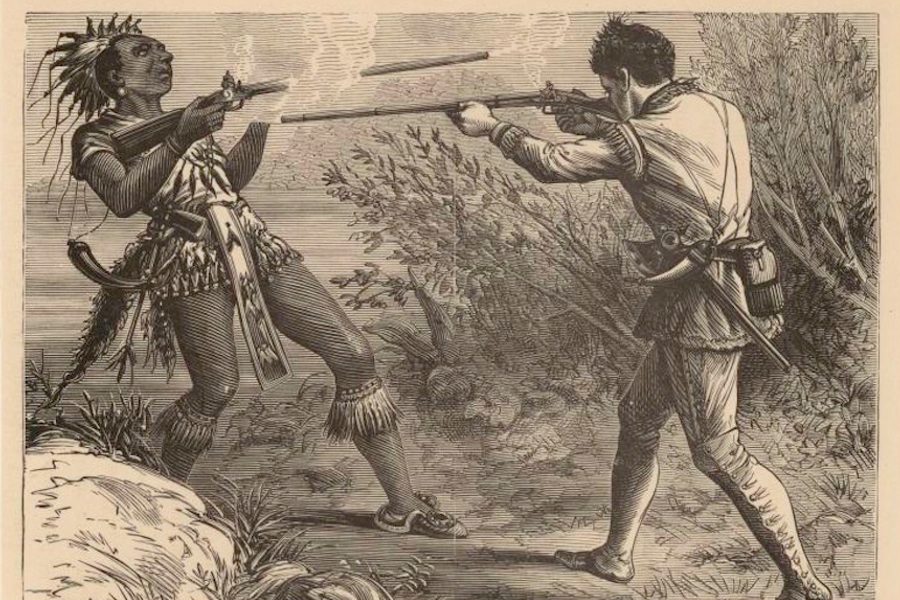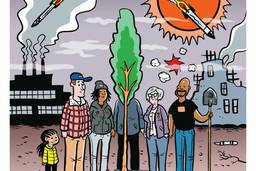The Stolen Children of Maine: Native Wabanaki Seek Truth, Reconciliation Amidst a Cultural Genocide
Dayton Martindale

My great-great-grandfather was brought into Taos, a city in what is now New Mexico, as a young Navajo boy around 1860. Slavery would soon be abolished, but at the time indigenous bondage was widespread. He was purchased — a typical price would have been 100 dollars — by Don Juan Santistevan, a Spanish man whose settler family had been in the region since at least the early 1700s. Santistevan had just lost his only son, and raised the Navajo boy as part of the family.
My ancestor may have obtained his life and his freedom, but he never rejoined Navajo society. His language and even his name — he was called Santiago Santistevan — became Spanish, and all threads of Navajo culture were lost in my family.
The destruction of Native cultures has taken many forms throughout our country’s history, from Manifest Destiny to mining operations, from blankets laced with smallpox to aggressive policing. According to the Center on Juvenile and Criminal Justice, Native Americans are the racial group most likely to be killed by law enforcement. But the displacement and assimilation of Native children is just as much a part of that history — and it didn’t end with my great-great grandfather.
From the late 1800s through the mid-1900s, indigenous children across the country were placed in boarding schools meant to assimilate them into white culture, a practice that proliferated throughout the country. Abuse was common practice in these institutions. Richard Henry Pratt, who in 1879 founded one of the first such schools in Carlisle, Pennsylvania, phrased his goals quite bluntly: “Kill the Indian in him, and save the man.”
Confronting Painful Truths
Denise Altvater was born in 1959, a Passamoquoddy child in Maine. She and her sisters were taken from her home by child welfare services when she was seven years old and forced into foster care, where she recalls being raped, starved and forced to sleep among rats. She eventually ended up in a kinder foster home, but even there she was discouraged from speaking of her heritage. Altvater now works in the field of indigenous child welfare, but reentering the tribe has been a long and often excruciating process. She has been suicidal at times, and struggled with her own personal relationships. “I wasn’t the best parent,” she told me. “I didn’t know how to be a parent.”
Genocide, as defined in the United Nations’ 1948 Convention on the Prevention and Punishment of the Crime of Genocide, includes “forcibly transferring children of the group to another group” when done “with intent to destroy, in whole or in part, a national, ethnical, racial or religious group.” This (and other definitions) undeniably applies to our nation’s history with indigenous peoples. Less acknowledged is that, according to a June report out of Maine, the cultural genocide continues today.
That report, titled “Beyond the Mandate: Continuing the Conversation,” zeroes in on what might be evil at its most banal: the intricacies of child-welfare laws. “Beyond the Mandate” shows that Native children are disproportionally put into foster care or put up for adoption, often taken in by non-Native foster families unwilling or unable to preserve the child’s language and heritage.
Sadly, this problem is not unique to Maine. As Truthout recently reported, over half of South Dakota children in foster care are indigenous, despite indigenous children making up only 15 percent of the youth population. And nearly nine in ten of these were in non-Native foster homes.
But while other states face similar issues, Maine’s “Beyond the Mandate” is the first report on indigenous child welfare in the United States to be created by a “truth and reconciliation commission” (TRC) — the Maine Wabanaki-State Child Welfare Truth and Reconciliation Commission.
The TRC model arose in Latin America in the 1980s but was popularized in post-apartheid South Africa. While some criticize these commissions for being unable to enforce real accountability, proponents argue that an honest appraisal of injustice can be a radical first step towards change.
The People of the Dawn
There are four Wabanaki tribes living in Maine, primarily in the state’s northern half: the Passamaquoddy, who have two reservations, the Maliseet and Penobscot, who have one each, and the Micmac, who have no formal reservation in Maine but own land and a cultural center in Aroostook County. The TRC’s report comes at a time of high tensions between these tribes and the Maine government.
The Passamaquoddy and the Penobscot announced on May 26 that they would be removing their delegates to the Maine state legislature. In a tradition dating back to the 1800s, these tribes had sent a non-voting representative to Augusta, Maine’s capital, to discuss and propose policy. “Our hope is that one day the state will … value the tribes as sovereign partners and engage in a relationship of mutual respect,” said Matthew Dana, the Passamaquoddy representative, as reported in the Portland Press Herald. “Until then, we simply must decide our own future.” (The non-voting Maliseet representative will remain, and the Micmac do not have a representative.)
In April, Gov. Paul LePage had rescinded his own 2011 executive order requiring that Native peoples be directly consulted on state policy that affects them. This decision came amidst controversy over indigenous fishing rights and local water quality. To the four remaining Wabanaki tribes, these issues bode ill for the future.

The Penobscot Nation is currently in a legal battle with Maine over hunting and fishing rights along the Penobscot River. (Centpacrr / Wikmiedia Commons)
The ancestors of the Wabanaki, meaning “People of the Dawn” or “People of the Dawnland,” have inhabited present-day Maine and adjacent territories of present-day Canada (a region they call Wabanahkik, or “Dawnland”) since the retreat of the glaciers some 12,000 years ago. Maine is heavily forested even today, and Wabanaki economy and spirituality are connected to the state’s woods and rivers. At one time there were over 20 Wabanaki tribes, and an estimated 32,000 individuals. From 1616 to 1619, more than three in four died. This near extinction was mostly due to European disease, though more direct conflict with European humans also played a role.
For the next 400 years, Wabanaki relations with the British Crown and the U.S. government remained fraught with distrust and confrontation. Colonists placed bounties on Wabanaki scalps, kicked them off of their land and attempted — with varying success — to replace their traditional Earth-centered spirituality with Christianity. When the assimilatory boarding schools spread across the continent, Maine was no exception.
In Canada, indigenous people filed multiple class-action lawsuits over the country’s Indian residential schools, which were similar in intent and effect to the U.S.’s boarding schools, and the last of which closed in the 1990s. In addition to some financial reparations, these lawsuits led to the creation of a TRC (which also released a report this June) to facilitate the healing process. Thousands gathered for a week of events in Ottawa coinciding with the report, which ended with 94 specific recommendations for rectifying this historic injustice, some symbolic (apologies from the government and the pope, and including “Treaties with Indigenous Peoples” in the Oath of Citizenship) and others more material (reforms to the criminal justice system and increases in educational funding).
Not quite 300 gathered in Hebron, Maine, for the Wabanaki-State TRC’s closing ceremony, and the event lacked the national attention of its Canadian counterpart. But unlike many TRCs this one did not seek only to remediate and recover from the crimes of the past, but also to confront an ongoing tragedy — residential schools may have closed, but the Maine foster care system still discriminates.
‘Oh my God! … I’ve been an agent of genocide’
The Indian Child Welfare Act (ICWA), passed by Congress in 1978, granted tribal child welfare programs more authority in dealing with native kids. The goal was to limit the state’s ability to take native children out of their homes, and thus “promote the stability and security of Indian tribes and families.”
In Maine, such legislation was badly needed. In Aroostook County, home to a band of the Micmac People, 30 percent of Native children were in state foster care in 1972. Statewide, indigenous children were put in foster care at rates 25 times higher than other children that year. The TRC was unable to obtain precise data on the given justifications for taking these children away, but the commission points the finger at “institutional racism,” “historical trauma” and “contested sovereignties and jurisdictions between the state and the tribes.” While the report does not delve into this, indigenous people across the country face high rates of poverty, unemployment, incarceration and substance abuse.
ICWA helped, but it was no cure-all, and for years Maine regularly brushed the legislation aside. In 1999, a joint state-tribal venture sought to address the inadequacy of the state’s ICWA compliance. This workgroup prepared and delivered a training session for child services workers, explaining both what ICWA meant and why it was necessary. As part of this training, they recorded and showed a video of Altvater sharing her own horrific experience within the child welfare system. The ICWA Workgroup would eventually become Maine-Wabanaki REACH, an organization intended to seek solutions and help both Native and non-Native communities understand the issue.
The idea for a TRC first surfaced in 2008. The proposal grew out of a series of “painful discussions about privilege and racism,” says REACH co-director Esther Attean, who is half Wabanaki and a member of the Passamaquoddy tribe. Understanding the role past trauma and persisting prejudice still play in tribal-state interactions, the group felt a TRC might be able to bring much of this historical baggage to light.
Attean, Altvater and other Wabanaki spent two years pursuing the idea, and in February 2011 presented a declaration of intent for a TRC to the state. The declaration received pushback — which Attean sees as a sign of “respect for the process,” a departure from the norm in which tribal people are “placated” out of “political correctness” — and in May they went back to work to rewrite the declaration, this time with the state playing an active role.
In June 2012, Gov. LePage and five Wabanaki chiefs (between them representing all four remaining tribes) signed a Mandate for the Maine Wabanaki-State Child Welfare TRC. The fact that both sides — the state and the tribes — had mutually endorsed the commission is unique among TRCs.
Once the five commissioners — two of whom are Native, though none of whom are Wabanaki — had been chosen, they spent 27 months researching and preparing their report. They used data from Maine’s Department of Health and Human Services (DHHS) and collected 159 statements — 95 from Native people and 64 from non-Natives.
This process was not easy. The TRC was “building a plane as we were flying it,” remembers Attean. The work required “decolonizing your mind and your heart. It takes a lot of trust and a lot of love … At many points in the process the commission and REACH bumped heads — we bumped up about white privilege and racism like you wouldn’t believe.”
While the going was stressful, Attean is “very pleased” with the final product. The statistics are troubling: Native children were 5.1 times more likely to be taken by child services over the last 13 years as non-Native children, and as late as 2012, Maine placed half of the Wabanaki children in its care into non-Native households. The commission’s findings are summarized into 16 points at the end of the report, as well as 14 recommendations for the future: Infringements on Native sovereignty must be reined in, funding must be more accessible for Native child welfare and foster homes, ICWA compliance must be strengthened and the reality of genocide must be acknowledged and worked through. It is now REACH’s task to help the state and the tribes to implement these proposals.
Reading the document, it becomes apparent that conscious malice is only one component of the predicament. There are stories of actively racist foster parents who physically and emotionally abuse Native children, causing lasting harm by prohibiting children from learning their indigenous language or making them ashamed of their heritage. But simple ignorance can be at least as devastating as direct malevolence. DHHS workers were not trained in ICWA compliance for decades, and many had never considered the special cultural needs of Wabanaki children. “Oh my God!” one DHHS worker remembers thinking during a long-overdue ICWA training. “I’ve been an agent of genocide.”
ICWA, if implemented correctly, would keep Native children out of the state system and within their tribe whenever possible. But the commission found that before 1999, no concerted effort had been made by the state to explain ICWA regulations to child welfare workers, and even now more could be done to impart the law’s significance.
From 2006 to 2009 up to 53 percent of children did not have their Native ancestry verified, meaning a number of Wabanaki children were thrust into the state system without ICWA protection. A DHHS worker (statement-providers were not identified by name in the report) spoke of simply assuming that white-looking children were white, without asking whether they had Wabanaki heritage.
ICWA also prioritizes placing children with relatives, recognizing that for many indigenous cultures (including the Wakanabi), extended kin networks are important in child rearing. The DHHS, on the other hand, operated under a different premise: multiple workers recall hearing that “the apple doesn’t fall far from the tree.” If the state found a parent’s childcare to be inadequate, it was assumed that the parent’s relatives were also untrustworthy, and children were usually moved into entirely different (often non-Native) families. A former tribal judge reflected that this dislocation “can be more damaging to the child than the reason that the department got involved in the first place.”
Altvater, after years of reflecting on her own life and listening to other people’s similar experiences, would agree. “I really believe the number one trauma … was the fact that people were taken from their homes,” she says. “Didn’t matter if you went to a good home or a bad home, if you were taken in a good way or a bad way — their entire lives, they never felt like they belonged anywhere.”
‘Nations Within a Nation’
According to the report, “precise boundaries of self-government, sovereignty and jurisdiction were left undefined” by Maine’s legal system, “a situation that has since created legal, social, economic and racial friction.” Child welfare laws vary in how they affect each tribe, and differ on both sides of the Maine-Canada border. While officially Maine respects Wabanaki jurisdiction, one tribal judge commented that in practice Maine seems “to believe that the [Wabanaki] nation is not a nation, that it is a municipality and it’s still under their authority. And as long as that continues, there are going to be problems.”
The tribal child welfare service, according to one social-services director, makes more of an effort to keep children with their families than the DHHS does. The tribal courts — which outsiders originally treated as a joke — strive to be more humane and attentive than the state, and make a point of recognizing the parent’s dignity. “The value of a person is still present even if they have a substance abuse issue,” one judge remarked. “The tribe’s concept of people is so much healthier than in the state court.”
But more often than not it is the state that has the final say. The Micmac and Maliseet do not have their own court system (which the TRC recommends should change), and the courts of the Penobscot and Passamaquoddy only apply to tribal members who live within their territory. Maine governmental workers struggle to reconcile themselves to the idea of “nations within a nation,” and the bureaucratic hurdles of ICWA are seen as a hassle rather than a necessary protection.
There are 8,000 remaining Wabanaki in Maine (out of a total population of over a million), and the number is decreasing. The state decides who is Indian (and thus who deserves ICWA protection) by “blood quantum,” simply crunching numbers based on family heritage. Many in the tribes, on the other hand, would prefer to self-define their own culture and membership. A non-Native tribal attorney put the issue bleakly: “If blood quantum is the determining factor, eventually the math is that … some of the tribes will become extinct.”
This honesty and forthrightness is what makes the moving testimonies of “Beyond the Mandate” so necessary and compelling. Through their words the Wabanaki people become not merely numbers or an administrative burden, but a vibrant community fighting to survive, watching their future slowly and methodically ripped away, quite literally, by the state. As TRC Executive Director Charlotte Bacon puts it, “Since this issue connects so intimately to what many of us hold dearest, we cannot pretend that what happens to any child in this state does not in some way matter to all of us who love our families.”
But this is more than just a community losing its children. While the details of the TRC’s report are unique to Maine and the Wabanaki, it is one chapter in a broader story that rings true across the continent, from Taos, New Mexico, to Carlisle, Pennsylvania. In February the Bureau of Indian Affairs released new guidelines meant to improve ICWA, and more and more states are realizing the harm caused by their child welfare services.
In many Native communities genocide is not a thing of the past, but an everyday struggle. The visceral nature of this trauma is perhaps starkest in an anecdote from a former Wabanaki health director: After a severe ice storm in 1998, the tribes received substantial donations of blankets. No one would take them. Generations later, the memory of smallpox was still too fresh.
The past has not left an easy legacy for the present, but one Wabanaki chief, not identified in the report, is hopeful about the legacy we can leave the future. Rather than focus on demanding rights, he argued, the Wabanaki must offer their alternative worldview and value system as the basis for potential solutions to the environmental crisis. While the dominant culture wreaks havoc on the living world, the ecologically conscious Wabanaki can “provide a voice … to those yet to come.” The chief has found that this voice draws people to the indigenous cause — Native viewpoints no longer just deserve to be heard, but are essential to survival.
Not all Wabanaki who were asked agreed to give statements to the Maine TRC. Some had hoped the commission would have more teeth, with the capacity to levy reparations, and others felt it was too soon for reconciliation. Nonetheless, the TRC’s report does manage to give a voice to a group too often silenced in this country. In its sobering pages, we discover how easily racism, ignorance and the inertia of past injustice can fuel a continuing genocide.
Despite current tensions between Gov. LePage and the tribes, the issue of child welfare has been able to foster collaboration in recent years. Attean hopes that Maine will adopt the TRC’s recommendations, and more indigenous children will retain their cultural heritage — beginning to reverse a centuries-long genocide. Ideally, she says, the truth and reconciliation process will serve as a model for other states and tribes.
Altvater has been sharing her story for well over a decade, and it hasn’t always been easy. But the commission’s conclusions are validating. “To me it legitimizes things that we’ve been saying for a long, long time, and people just ignore and say just get over it.” The TRC’s report is difficult to ignore, and the years of pain contained within are difficult to get over. By looking the past in the eye, Maine and the Wabanaki may have made it possible to finally start moving forward.
(Sign up at the top of this page to be notified of more stories on Rural America In These Times like this one.)
Dayton Martindale is a freelance writer and former associate editor at In These Times. His work has also appeared in Boston Review, Earth Island Journal, Harbinger and The Next System Project. Follow him on Twitter: @DaytonRMartind.








